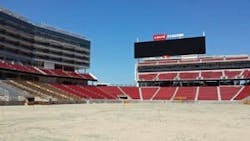About the author: Mark Handzel is vice president, product regulatory affairs, and director, HVAC commercial buildings, for Xylem. Handzel can be reached at [email protected] or 847.966.3700.
When plans were being developed for the $1.3 billion Levi’s Stadium in Santa Clara, Calif., home to the NFL’s San Francisco 49ers, water management was a top priority from the start.
The location itself was the first decision that signaled this was to be no ordinary endeavor. The city of Santa Clara is known for having one of the most forward-thinking recycled water programs in California. By connecting to the Santa Clara Valley Water District’s recycling system, planners could leverage a drought-proof water source for the stadium’s flushing and irrigation systems.
“The system needed to be both innovative and high performing,” said Kevin Coyne, vice president of FW Spencer, one of the plumbing contractors on the project.
In designing the internal plumbing system for the 68,500-seat stadium—which included twice as many toilets as at Candlestick Park, the 49ers’ former stadium—efficiency was critical. According to stadium water assessment estimates, the recycled water system will save more than 42 million gal of water per year.
Thinking Outside the Bowl
The recycled water pressure booster system built by California Hydronics Corp. (CHC) uses Bell & Gossett pumps, heat exchangers and other products. “Based on our successful history working with CHC, we knew the Bell & Gossett products would handle the extreme fluctuations of the stadium’s systems,” Coyne said.
All of the Bell & Gossett products included in the stadium’s building systems are noted for their efficiency, and were selected by Turner-Devcon, which drafted design development drawings and specifications with the support of M-E Engineers. Plumbing contractors ACCO and FW Spencer completed the permit packages.
Bell & Gossett products used in the system included:
- 1510 end suction base-mounted pumps: Efficient hydraulic design and back pullout capability offer reduced downtime and decreased maintenance costs.
- Series 60 inline pumps: The series enables flows to 200 gal per minute and heads to 55 ft, which helped meet the demands of the system.
- Rolairtrol air separators: The patented centrifugal-style air separator creates a low-pressure vortex in the center of the tank that helps remove entrained air in the system quickly and efficiently.
- VSX double suction pumps: These pumps offer a reduced footprint and enhanced performance in any flange configuration.
- Brazed plate heat exchangers: Vacuum brazed stainless steel plates form a durable, integral piece that can withstand the high pressures and temperatures of a complex system.
- GPX plate and frame heat exchangers: The plate design provides greater heat transfer in a compact design, offering the highest level of thermal efficiency for the condenser water system.
The e-SV multistage pumps from Goulds Water Technology, a Xylem brand, also were designed into the system, as their lower energy requirement meets the energy-efficiency needs of the stadium.
A recycled water pressure booster system helps ensure adequate water is available when demand is at its highest, like during halftime at a football game.
Before the stadium was packed with fans, a “super flush” was conducted to make sure the system could handle the demand that would be put on it on game day. In April 2014, hundreds of workers and volunteers simultaneously flushed every toilet and urinal and turned on every sink in the stadium for about 30 minutes.
The system handled the test with flying colors, and on June 10, 2014, the stadium was connected to Santa Clara’s recycled water system.
Leading the Plunge
On July 22, 2014, Levi’s Stadium received Leadership in Energy & Environmental Design (LEED) Gold certification, a first for an NFL stadium. Thirty-nine points are required for Gold certification, and the stadium earned 41 points.
Awarded by the U.S. Green Building Council, LEED status is determined by evaluating buildings and assigning points on standards. The categories range from the sustainability of the building site to indoor environmental quality to water efficiency. The number of points received for each category determines the LEED level.
The recycled water system played a key role in the stadium’s LEED certification, as it accounts for 85% of the facility’s water usage, primarily through flushing and irrigation.
In the water efficiency category, the stadium received five out of five points, which demonstrates excellence in innovative efficiency in landscaping, water use reduction and wastewater technologies. This achievement was due, in part, to the design and use of a reclaimed water system for both potable and non-potable applications.
Water efficiency was just one of two categories in which the stadium met all of the evaluation requirements—the other was for innovation in design. Although Levi’s Stadium is not the first stadium to utilize water reuse technology, the extensive use of this technology helped it meet all of the evaluation criteria.
“Every detail regarding environmental sustainability was addressed during planning and construction,” said Ken Carey of CHC. “This project is a bellwether for others to follow.”
Plumbed for Success
Recycled water is the cornerstone of sustainability at Levi’s Stadium. Whether flushing toilets or irrigating the playing field or the 27,000-sq-ft green roof—one of the distinguishing features of the open-air stadium—the reclaimed water system is at the heart of the structure.
A live dashboard display that highlights energy measurements and other green features gives fans and visitors an opportunity to see the real-time results of the sustainable practices in action.
The 49ers played the 2014 season in their new home, and the stadium has hosted myriad other events since it opened, including college and high school football games, soccer matches and concerts. The stadium is scheduled to host Super Bowl 50 on Feb. 7, 2016, to a crowd of more than 70,000 people. That is when the innovation and technology that went into making Levi’s Stadium the greenest NFL venue in the country will be on display before a worldwide audience.
Download: Here
